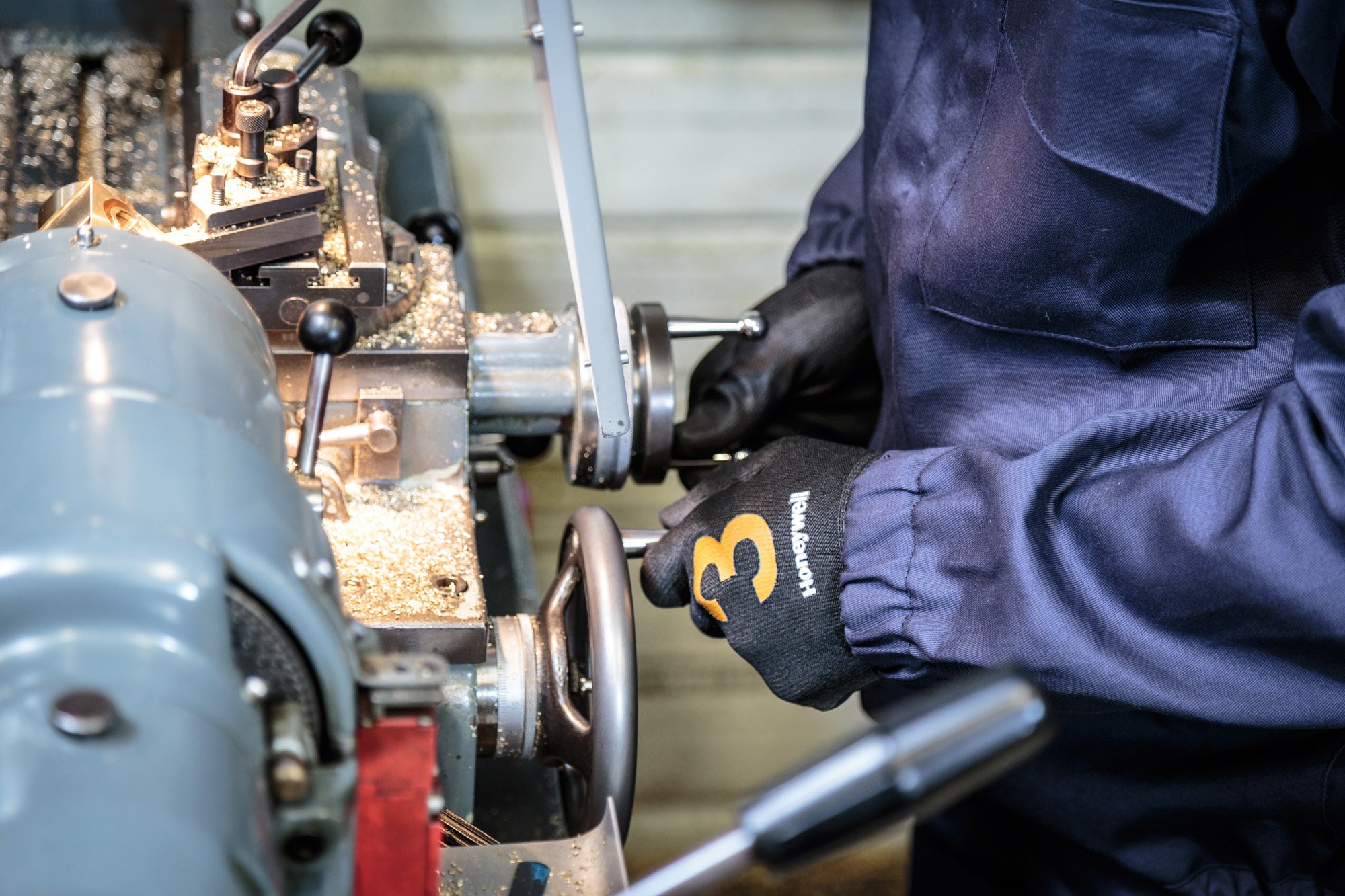New hand protection standards fit like a glove
Protective gloves provide an essential line of defense but how can industrial users ensure they procure the right ones for the job at hand? As Peggy Mandozi, Hand Protection Product Manager for Honeywell Industrial Safety, EMEA explains, new EN hand protection standards for cut protective and chemical gloves make glove selection much easier.

By Peggy Mandozi, Honeywell Industrial Safety, EMEA
The right gloves for the right job
Industrial settings are by their very nature tough environments to operate in and workers face many different mechanical and chemical hazards on a daily basis. Worker health and safety therefore is paramount. Manual handling that involves contact with sharp edges can, in worst case scenarios, result in serious injuries. Problems can also occur with infections of uncovered cuts or contamination with chemicals. [1]
The law requires employers to make a suitable and sufficient assessment of the risks to health. The Health and Safety Executive (HSE) explains when personal protective equipment (PPE) should be used in the Personal Protective Equipment at Work Regulations 1992. [2] In certain industrial applications, the use of cut protective and chemically resistant gloves is an essential line of defense.
However, the selection of suitable protective gloves can be complicated and the degree of protection they offer is not always easy to ascertain. The HSE advises employers to seek guidance from manufacturers/distributors when choosing gloves because they are best placed to provide the glove performance data. This is particularly relevant for chemically resistant gloves where the data can be used to predict the permeation, penetration and degradation of glove materials by specific chemical agents. [3]
Two new European (EN) standards, which were published at the end 2016, will make it easier for those responsible for procuring cut protective and chemically resistant gloves to choose the products that best meet their needs.
Problems with EN 388
Introduced in 2003, the European Standard EN 388 covers the test requirements for safety gloves that are sold to guard against mechanical risks such as cuts and abrasions, which are a significant cause of occupational hand injuries. Since the standard came into force, manufacturers have continued to develop glove technology to enhance the quality of products, using a range of innovative materials such high performance polyethylene (HPPE), glass and steel fibres to provide better comfort for workers and improve levels of protection.
However, the existing EN 388 standard does not reflect these important developments and the reliability of the current test method for higher cut levels – the coupe test – has been queried. The blades that are used in the coupe test machine are not changed throughout the test, which is not a problem for low levels of cut protection. However, for new, advanced products that contain glass or steel in the fibre, the current test is less precise. The problem is that the blade can be blunted after coming into contact with these materials and consequently the test gives a score that is inconsistent and does not reflect the actual performance of the material.
New test method and markings on safety gloves
As a result, the Standard Committee has decided to enhance the standards by introducing a new test method – ISO 13997 TDM, which demonstrates a much more precise cut performance and offers more meaningful results for gloves with a 4 or 5 rating. The test involves a straight blade which is drawn across the sample in one movement, with a new blade used every time.
The revision has taken on-board all of the improvements in product technology and components to make sure the results are meaningful for the end user. This means it will be easier for the end user to choose the right gloves because they will show a consistency in the test results and be able to procure gloves, for example, that contain steel fibres, which offer the protection they need.
Importantly, the new standard will change the markings on safety gloves. In the current standard, there are four numbers to express performance – abrasion (1 to 4); cut (1 to 5, the coupe test); tear (1 to 4); and puncture (1 to 4). The new EN 388 standard keeps the first four numbers. However, the fifth position reflects the ISO test score (A to F). If the glove passes an impact protection test, the letter ‘P’ appears in the sixth position. The impact test, which is performed on the back of the glove, is another addition to the new standard and demonstrates if products that are claiming impact protection have passed or failed this test.
Manufacturers will need to recertify their products to ensure they meet the new requirements. Before placing the products on the market, the gloves will need to reflect the new markings for the ISO 13997 TDM test and the impact test.
It’s important that employers in all industries understand the markings on the gloves because it will impact on their day-to-day work. At Honeywell, we will be providing a selection of tools, including a video, to help end users understand the new classification, what it means and how the product can protect them in different handling situations.
Change for chemical and micro-organism protection
A second important change relates to EN 374: 2003, the standard for gloves that provide protection from chemicals and micro-organisms, which is being developed to simplify and accurately determine the variability of test results.
The hand protection standard now appears in two rather than four parts. The first –
EN ISO 374-1 –now includes all test methods relative to permeation, penetration and degradation. It will also comprise three different categories, reflecting the gloves’ resistance to chemicals (see box) and all products must be marked based on the category result. In addition, six new substances will be added to the current list of 12 chemicals.
The second – EN ISO 374-5 – includes all tests methods relative to penetration and permeation of biological substances.

Author: Peggy Mandozi, Hand Protection Product Manager for Honeywell Industrial Safety, EMEA
In the existing standards, there are different parts to EN 374 and often when the manufacturer talks to the end user, it is clear that they don’t know which one to rely on. For example, EN 374-3 gloves are tested for three chemicals out of a list of 12. However, the issue is that the current marking on the gloves does not distinguish between a basic and high performance chemical protection. Generally, they claim the same chemical substances, which makes it very difficult for the end users to choose the best gloves. The new standard tells them: if you have a low chemical exposure, it’s better to use a Type C glove, alternatively, if you have a high chemical exposure, a Type A glove is more suitable.
As part of the new version of the standard, gloves have to undergo a degradation test to measure the glove mechanical properties after it has been dipped for two hours in the chemical. Like for EN 388, every manufacturer will have two years to update the product marking. Depending on the certification timeline, manufacturers will start to make new gloves available by mid-2017.
Further reading and support
While the new EN ISO 374 has been developed to simplify and determine the variability of test results, the industry has also developed a range of tools to help end users select the most appropriate gloves for the task at hand. This includes a dedicated website from Honeywell that provides expertise in analysing chemical risks, so that end users can choose the gloves they need depending on the chemical exposure, both for single chemicals and also for chemical combinations.
The new EN 388 and EN ISO 374 standards are important developments in the safety industry. The new markings will help end users gain a better understanding of the levels of protection that cut protective and chemical gloves offer and enable them to choose the most appropriate products for the work environment.
For more information about Honeywell Industrial Safety, its products and services, visit the website at http://www.honeywellsafety.com.
Contact: Marco Giudici, Technical Publicity Ltd, for Honeywell Industrial Safety [email protected]
New hand protection standards fit like a glove
Protective gloves provide an essential line of defense but how can industrial users ensure they procure the right ones for
Safety & Health Practitioner
SHP - Health and Safety News, Legislation, PPE, CPD and Resources Related Topics
Future-proofing safety: Five trends shaping the PPE landscape of tomorrow
Arco backs SHP campaign for PPE inclusivity
Beth Holroyd: ‘PPE that’s not designed with women in mind is a fundamental problem’



A refreshing review of “effectiveness” of PPE just a shame DSE user operators have not seen the effectiveness of occupational health regulation / legislation reviewed and the majority continue to experience the debilitating consequences of failure to prevent and/or even mitigate sub-standard display screen interface ergonomics impairing performance, productivity and increased risk to their physical and mental health.